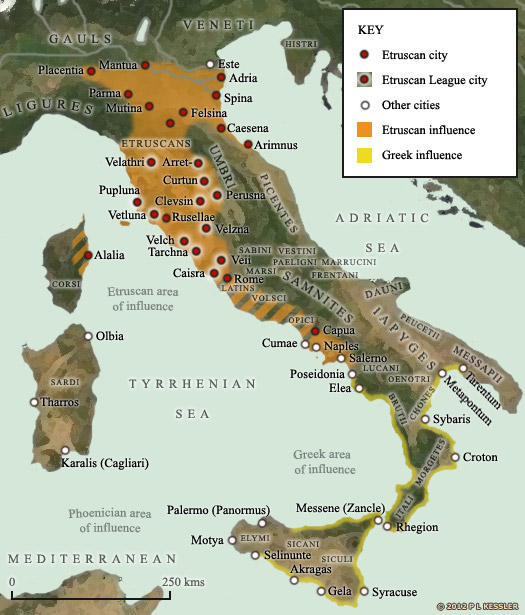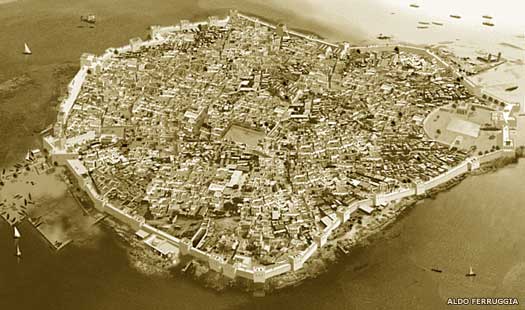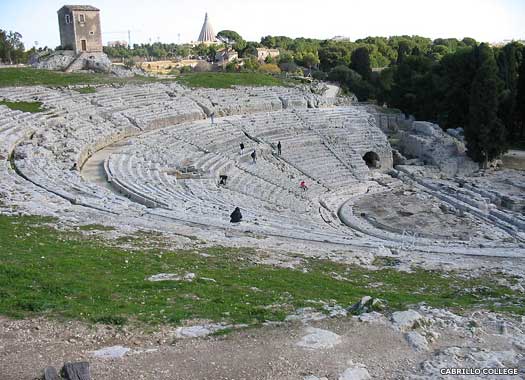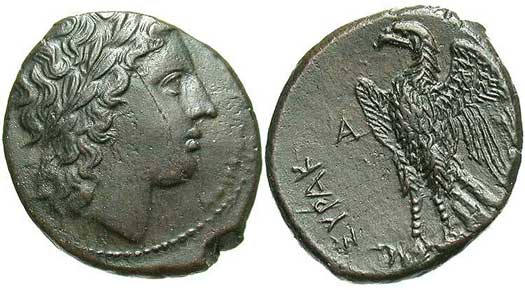
| SYRACUSE Syracuse is located in south-western Sicily. The first major colony on the island, it was founded between 743-734 BC by the city state of Corinth during the period of Greek civilisation which saw colonies founded throughout the Mediterranean. This was later than an equivalent phase of colony-founding by the Phoenicians, so the Greeks found themselves competing against cities such as Carthage, Utica and Gadir. The Greeks were able to devote far more resources than the Phoenicians, so they were able to catch up fairly quickly, and Syracuse quickly grew into the most powerful of the Greek colonies, at times controlling the entire island. The rulers were known as tyrants.
743 - 484 BC :
Once the colony of Syracuse is established by Corinth it is governed by an oligarchy of the most powerful Greeks (perhaps descended from the Bacchiades, whose exile from Corinth is claimed as the reason Syracuse is founded). The native Siculi are forced inland, but many of their number are also subjugated and are used as a labour and farming force by the Greeks. Towards the end of this period the city falls under the control of another Greek colony, that of Gela, which introduces a kingship, or tyranny, to rule the city.
This map shows the greatest extent of Greek influence in southern Italy and on Sicily, during the fifth and fourth centuries BC, when the Etruscans were a major rival 580 BC :
Some Greek settlements on Sicily attempt to drive the Phoenicians from Motya and Panormus (Palermo) in the west of the island. The Carthaginians fear that if the Greeks win the whole of Sicily they will next move onto Sardinia and beyond, isolating the Phoenicians in North Africa. The successful defence of Sicily is followed by attempts to strengthen limited footholds on Sardinia. A fortress at Monte Sirai in Sardinia is the oldest Phoenician military building in the west.
492 BC :
The Syracusan colony of Camarina rebels, giving Hippocrates of Gela the excuse to attack Syracuse itself. The city's army is defeated at the River Heloros and Syracuse is besieged. Eventually, Hippocrates is bought off with the offer of the possession of Camarina.
484 BC :
The successor to Hippocrates in Gela, Gelon conquers Syracuse and moves his seat to the city, handing the rule of Gela to his brother, Hieron.
484 - 478 BC :
Gelon I / Gelo I : Son of Deinomenes. Tyrant of Gela (491-484 BC).
480 BC :
Hamilcar of Carthage lands a huge army on Sicily in order to confront Syracuse on the island's eastern coast. The Carthaginians are defeated by the Greeks at the Battle of Himera. A long struggle ensues with intermittent warfare between Carthage and Syracuse.
478 - 467 BC :
Hieron I / Hiero I : Brother. Tyrant of Gela (484-478 BC).
476 BC :
Less than a year after victory at the Battle of the Cremora, the Etruscan city of Veii sees its navy crushed off the coast of Cumae by Hieron and the city is forced to agree a treaty with Rome.
466 - 465 BC :
Thrasybulus : Brother. Ruled for eleven months.
465 - 405 BC :
Thrasybulus, the last of the three Deinomenid tyrants, is overthrown by the Syracusan people and a democratic republic is established to govern the city.
460 - 452 BC :
The recent termination of the tyranny of Gelon I and his brothers has left problems in its wake on Sicily. In 460 BC, war breaks out between Syracuse and its former colony at Catana. Ducetius, a prominent Hellenised Sicel, backs Syracuse in revenge for the former occupation of Siculi land by Catana, and the latter colony is defeated. Ducetius goes on to unite central Sicily, by 452 BC, and founds the city of Palice, which becomes his capital.
452 - 451 BC :
Syracuse becomes concerned by the seemingly unstoppable expansion by the leader of the Siculi. Ducetius takes Motya (the modern island of San Pantaleo), a stronghold which had formerly been held by Akragas, so in 451 BC Syracuse assists Akragas in opposing him, unsuccessfully. The power of Ducetius and his Siculi empire is now at its height.
The colony of Motya (modern San Pantaleo) on Syracuse changed hands twice during the revolt, with Ducetius of the Siculi at the centre of the fighting in his attempts to oppose Greek dominance 450 BC :
Ducetius of the Siculi suffers a shock defeat when his forces are decisively defeated at Nomae. His surviving army is scattered amongst the Siculi cities, and Ducetius remains with just a handful of followers. Akragas reclaims Motya and Ducetius flees to Syracuse, where he is tried by a general assembly and exiled to Corinth for life.
446 - 440 BC :
Ducetius returns to Sicily, according to Diodorus, where he founds the city of Kale Akte or Caleacte on the northern coast (modern Caronia). This is probably with the permission of Syracuse, in the hope of establishing a permanent peaceful alliance. Unfortunately, Ducetius dies following an illness in 440 BC, and is unable to influence the subsequent revolt of the Siculi against Syracuse. The revolt quickly falls apart, the city of Palice is sacked, and its Sicel inhabitants are sold into slavery.
431 - 404 BC :
The Second Peloponnesian War brings mighty Athens and its empire to its knees and establishes Sparta as the greatest Greek power. Syracuse sides with Sparta. When an Athenian fleet is sent to capture the island, the arrival of a Spartan general (Alcibiades, a former Athenian who had fallen from grace) and a few Spartan troops inspires the Syracusans to fight back, and a massive night attack by the Athenians turns into a disaster for them. Thousands of Athenian troops die. Dionysius is elected supreme military commander in 406 BC, and in the following year he seizes absolute power as tyrant.
420 BC :
Antiochus of Syracuse completes his History of Sicily and Colonising of Italy around this time. The works exist today only in fragments but they are highly regarded by the ancient world thanks to the accuracy of their information. Antiochus writes that the entirety of later Calabria had originally been known as Oenotria after the Oenotri tribe which had settled there early in its history. He also confirms that the arrival of the more warlike Oenotri and Opici had triggered the migration of the Elymi, Itali, and Siculi into the 'toe' of Italy and onto Sicily.
405 - 367 BC :
Dionysius I the Elder : Renowned as a cruel tyrant. Poisoned.
385 BC :
Dionysius supports and instigates an attack by Illyrians on the kingdom of Epirus. He wants to place Alcetas on the Epiran throne as part of his plan to control the entire Ionian Sea. Sparta intervenes and expels the Illyrians after defeating them in battle, although the Illyrians are reputed to kill 15,000 Molossians before they are expelled and ravage the region.
c.383 BC :
Hanno the Great of Carthage renews the war with Syracuse amid a power struggle in the city. This act wins him massive public support at home.
367 BC :
The war against Carthage finally comes to an end when Hanno the Great leads a fleet of two hundred ships to a decisive naval victory over Syracuse. Soon afterwards, Dionysius is apparently poisoned on the orders of his son.
367 - 356 BC :
Dionysius II the Younger : Son. Overthrown but returned in 347 BC.
367 - 366 BC :
Dion : Uncle, philosopher and supervisor of his nephew's rule.
366 BC :
Dion attempts to improve his nephew's dissolute reign by inviting the philosopher Plato to visit the island. Together Dion and Plato try to restructure the ruling process to introduce moderation, but Dionysius resents the interference and Dion is banished. Dionysius gradually loses popularity with his relatively incompetent rule.
357 BC :
Much to the relief of most of the Syracusan populace, Dion returns with a small army and Dionysius, away at the time, is left with little choice but to capitulate and abdicate the throne, sailing to Locri on the Italian mainland. He leaves the only uncaptured portion of territory, the citadel of Syracuse, in the hands of his son, Apollocrates.
356 - 354 BC :
Dion : Seized the throne. Assassinated by his officers.
354 BC :
The conservative Dion has become increasingly unpopular, generating growing opposition to his rule. Thanks to the machinations of Calippos, he is assassinated by his own mercenary officers. Calippos seizes control, the first of many who claim the title of tyrant during this period.
The fifth century BC Greek theatre lies on the southern slopes of the Temenite Hill on Syracuse, still in surprisingly good condition despite centuries of spoilation 354 - 352 BC :
Calippos / Calippus : Opposed Dion and ruled for 13 months. Killed by his comrades.
352 - 350 BC :
Hipparinos : Son of Dionysius the Elder.
352 - 350 BC :
Aretaeos : Co-ruler.
350 - 346 BC :
Nysaeos
347 BC :
The period of anarchy engendered by the rule of Dion continues as Dionysius II resumes control of the city, although he remains unpopular with the people.
347 - 344 BC :
Dionysius II the Younger : Restored during a period of anarchy. Accepted exile in Corinth.
345 - 340 BC :
The Carthaginians launch a large-scale military campaign in Sicily. Thanks to a decade of anarchy Syracuse is no longer the supreme power it had once been in the Mediterranean. Lots of small powers, war bands and tribal princes seek to control their part of the island. Into this chaos Carthage sends a force of 50,000 infantry, backed by cavalry, a large fleet of war chariots, and a large train of siege engines.
The Greeks receive assistance from Corinth under the able commander Timoleon who opposes Dionysius in 345 BC. Faced with an opponent he is unable to defeat, Dionysius accepts exile to Corinth where, after a year of declining living conditions, he dies. Timoleon spends the next five years driving out the invaders and becomes the colony's leading figure (although not tyrant).
345 - 337 BC :
Timoleon : Opposed Dionysius. Led the defence of the city. Retired.
337 - 317 BC :
Thanks to the democratic reforms of Timoleon, Syracuse adopts a system towards which it has been heading since the fall of Dionysius the Younger, by which the city state is governed as a form of oligarchic republic. The young Agathocles, son of a potter, twice attempts to overthrow the party controlling the state. In 317 BC he returns from banishment with a mercenary army, subdues the city, and subsequently conquers much of Sicily.
317 - 289 BC :
Agathocles : Adopted the title 'King of Sicily' in 305 BC. Poisoned.
310 - 307 BC :
Greek armies under Agathocles invade Cape Bon near Carthage, but with disappointing results. At the same time, in 307 BC, Agathocles destroys the Elymi city of Segesta.
289 - 270 BC :
Following the death of Agathocles, apparently at the instigation of his own troublesome son, Archagathus, Syracuse is gripped by civil war and anarchy. Icetas is the first to claim to rule the city.
Shown here are two sides of a coin minted in Syracuse about 280 BC, around the crossover between Icetas, Toinon, and Sosistratos 289 - 280 BC :
Icetas
282 - 278 BC :
The growing power of Rome has saved the Greek colony of Thurii from being overwhelmed by the Italics, but the colony of Tarentum intervenes, sinking some of the Roman ships. Rome declares war on Tarentum, but Pyrrhus of Epirus declares for Tarentum, as do many of the southern Italic peoples, including the Brutii, Lucani, and Samnites. A few years later these three Italic tribes send auxiliaries to the army of Pyrrhus, but following his withdrawal in 278 BC to attack Syracuse they face Rome's might alone.
280 BC :
Toinon
280 - 277 BC :
Sosistratos
277 - 275 BC :
Epirus conquers Syracuse in 277 BC. When Pyrrhus leaves Sicily, one of his former generals, Hieron, is appointed commander-in-chief of the Syracusan armed forces. He strengthens his position by marrying the daughter of a leading citizen and is made king in 270 BC after successfully defending Syracuse from the Mamertines, mercenaries who had formerly been hired by Agathocles.
275 - 215 BC :
Hieron II / Hiero II : Illegitimate son of Hierocles, who claimed descent from Gelon.
263 BC :
Shortly after the outbreak of the First Punic War. Hieron signs a treaty with Rome by which he is allowed to continue to rule his corner of Sicily. His son, disagreeing with this policy, sides with the Carthaginians, but he dies shortly afterwards, perhaps killed by his own father.
240 - 216 BC :
Gelon II / Gelo II : Son. Killed after siding with Carthage.
215 - 214 BC :
Hieronymus : Son. Reigned for 13 months. Tyrant in the modern sense.
215 - 214 BC :
Following Hannibal Barca's defeat of a Roman army at the Battle of Cannae, Hieronymus enters into an alliance with Carthage. His actions see Syracuse besieged by Roman forces in 214 BC and he himself is cornered and killed on the streets of Leontini by supporters of Rome before his guards can come to his rescue.
214 - 212 BC :
Adranodoros : Seized power. Assassinated by the pro-Roman faction.
213 - 212 BC :
Hippocrates
213 - 212 BC :
Epicydes : Brother and general.
212 BC :
Despite holding out for two years against the Roman siege of the city, Syracuse falls. It seems that Roman troops are accidentally allowed into the city by a Syracusan peace party. Now Syracuse becomes the Roman capital of Sicily. Its subsequent history follows that of Italy until AD 827 when Sicily is gradually conquered by the Aghlabids of Tunisia.
Source :
https://www.historyfiles.co.uk/ |



